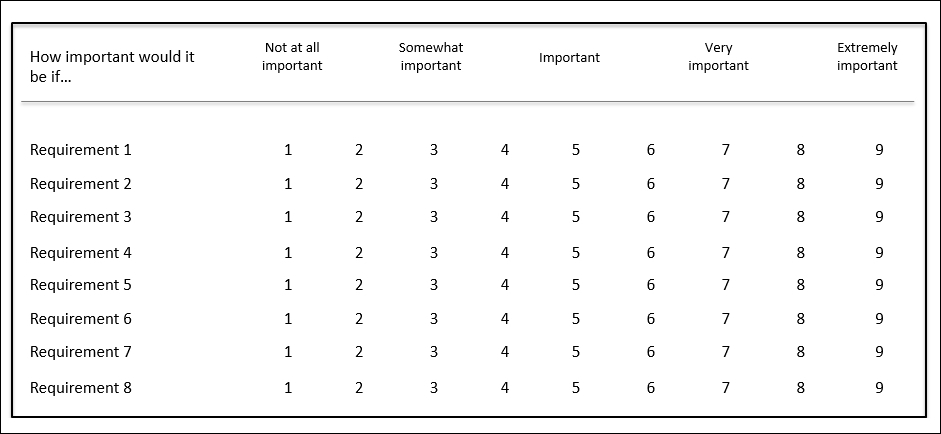"The great thing about fact-based decisions is that they can overrule the hierarchy" | ||
| --–Jeff Bezos | ||
In Chapter 7, Understanding the Customer's Voice, we discussed how to make sense of all the information we gathered during our interview process. We reviewed how to highlight our interview notes, and take those highlighted passages and transfer them to yellow sticky notes. We do this, of course, so we can group and prioritize the customer's needs we have been told about. After this, we transferred the most important 30-50 customers' voices and, through our translation worksheet, turned the customer voices into rudimentary requirements. We then performed another affinity process on these customer requirements and further reduced the number to 20-30 of the customers' most important needs. We grouped and prioritized the most important requirements.
When that is complete, you will have prioritized what you think the customer has told you are the most important customer requirements. You will have done this, of course, by interviewing a representative sample of your customers and while this is a very good beginning, it is also worth considering doing a more detailed analysis to see whether your assumptions are correct.
The process we described in Chapter 7, Understanding the Customer's Voice helped us to understand customer requirements. What this process did not do was help us understand which of these product attributes or requirements were the most important to the customer, which product attributes were an absolute "must-have" in the eyes of the customer, and which of these would have a higher influence on customer satisfaction than the others.
At this point, it is often necessary to assemble the information you have gotten this far and then go back to some of the same customers, or different customers, to help you prioritize what needs to be done and why.
Since you have extracted the customer requirements from your interviews and images, it will be very easy to now take the customer requirements you have generated and make a questionnaire to help ascertain the real level of importance of each requirement. Your customer interviews probably consisted of 20-30 face-to-face meetings. To make the importance survey reliable, we recommend you survey 100-150 customers for each market segment you are targeting.
While most surveys get a 3-5% response rate, you really need to ensure you are getting a good cross-section of your customer base and are aiming for a 50-60% response rate. This will require some work with your marketing team to make sure customers are properly notified about the survey, that there is a proper incentive for their participation, and that there is a follow-up after the survey for those who did not respond.
The importance questionnaire format is shown in Figure 8.1. In this questionnaire, we list each of the possible requirements and have each customer rank each of them on a scale of 1-9, from not at all important to extremely important:

Figure 8.1: Linkert scale
When the questionnaires are returned, add up the ratings for each requirement and divide the total by the number of respondents, in order to determine each requirement's average rating. This will give you a prioritized list, as determined by your customers, of each of the customer requirements you have identified.
